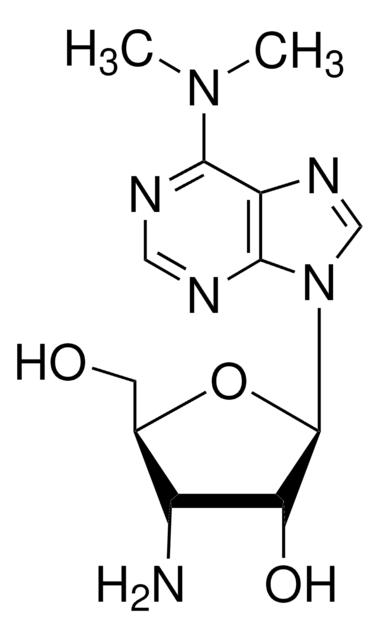SBR00017
Puromycin aminonucleoside Ready Made Solution
10 mg/mL in water
Synonym(s):
3′-Amino-3′-deoxy-N6,N6-dimethyladenosine
About This Item
Recommended Products
Assay
≥98%
Quality Level
form
liquid
concentration
10 mg/mL in water
antibiotic activity spectrum
Gram-positive bacteria
neoplastics
parasites
Mode of action
protein synthesis | interferes
storage temp.
2-8°C
SMILES string
N[C@H]1[C@@H](O)[C@H](N(C=N2)C3=C2C(N(C)C)=NC=N3)O[C@@H]1CO
InChI
1S/C12H18N6O3/c1-17(2)10-8-11(15-4-14-10)18(5-16-8)12-9(20)7(13)6(3-19)21-12/h4-7,9,12,19-20H,3,13H2,1-2H3
InChI key
RYSMHWILUNYBFW-UHFFFAOYSA-N
Biochem/physiol Actions
Puromycin aminonucleoside has also been used to probe endothelial glycosaminoglycan synthesis in cultured glomerular endothelial cells and their relation to cell permeability. A puromycin aminonucleoside nephrosis model of rat glomerular disease was also used to study the role of the neuron-specific ubiquitin C-terminal hydrolase protein gene product 9.5 (PGP 9.5).
Preparation Note
Storage Class Code
10 - Combustible liquids
WGK
WGK 2
Flash Point(F)
Not applicable
Flash Point(C)
Not applicable
Certificates of Analysis (COA)
Search for Certificates of Analysis (COA) by entering the products Lot/Batch Number. Lot and Batch Numbers can be found on a product’s label following the words ‘Lot’ or ‘Batch’.
Already Own This Product?
Find documentation for the products that you have recently purchased in the Document Library.
Customers Also Viewed
Our team of scientists has experience in all areas of research including Life Science, Material Science, Chemical Synthesis, Chromatography, Analytical and many others.
Contact Technical Service







